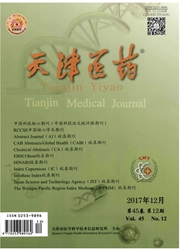

 中文摘要:
中文摘要:
目的评价超细支气管镜、Direct Path电子导航系统、Guide sheath(GS)外周超声小探头K201/K203系统、快速现场评价(玫瑰系统,ROSE)即四加技术(UNRE)引导下肺活检对外周(1/3)肺感染性病灶的诊断价值及安全性。方法连续纳入2014年4月1日—2015年3月31日在天津医科大学总医院就诊的胸部CT发现外周(1/3)肺感染性病变的患者共97例,将其随机分为四加技术组49例及非四加技术组48例,分别行四加技术或非四加技术引导下的经支气管肺活检(TBLB),分别比较四加技术组及非四加技术组的诊断率、安全性以及不同感染程度患者肺泡灌洗液肺泡巨噬细胞自发荧光强度的差异。结果四加技术组诊断率明显高于非四加技术组(81.63%vs 56.25%,χ2=7.313,P〈0.01),病灶包含支气管征亚组四加技术诊断率高于非四加技术组。所有患者均仅在活检时见少许出血,无咯血、气胸等并发症发生。处于不同感染状态的患者,其肺泡灌洗液肺泡巨噬细胞自发荧光强度亦不相同。结论四加技术引导下肺活检诊断率高、并发症少,选择合适的病例能够提高诊断率,肺泡灌洗液肺泡巨噬细胞自发荧光强度对外周(1/3)肺感染性病变的严重程度有提示作用。
 英文摘要:
英文摘要:
Objective To evaluate the diagnostic yield and safety of transbronchial lung biopsy (TBLB) under virtual bronchoscopic navigation (Direct Path), endobronchial ultrasonography with a guide sheath (GS) and rapid on-site evaluation using an uhrathin bronchoscopy (UNRE) for bacterial infection located in the peripheral third of the lung field. Methods Ninety-seven patients with bacterial infection, which located in the peripheral third of the lung field on CT images, were ran- domly assigned to UNRE (n=49) or non-UNRE (NUNRE, n=48) groups, who were treated in General Hospital of Tianjin Medical University between April 1, 2014 and March 31, 2015. The TBLB guided by UNRE was performed in two groups. The diagnostic yield, safety and complication rate were compared between two groups. Moreover, the differences of autofluo- rescence intensity of alveolar macrophage in alveolar lavage fluid were compared between two groups of patients. Results The diagnostic yield was significantly higher in UNRE group than that of NUNRE group (81.6% vs 56.2%, X2=7.313, P 〈 0.01). The diagnostic yield was higher in UNRE group with bronchus sign compared to that of NUNRE. All patients had a mild bleeding at the time of biopsy. There were no hemoptysis, pneumothorax or other serious complications. The autofluores- cence intensity of alveolar macrophage was different in different levels of infection in patients. Conclusion The procedure of UNRE has higher diagnostic rate and fewer complications. The careful selection of suitable cases can further improve the diagnostic accuracy. The autofluorescence intensity of alveolar macrophage in alveolar lavage fluid indicates the severity of infection in patients.
 同期刊论文项目
同期刊论文项目
 同项目期刊论文
同项目期刊论文
 期刊信息
期刊信息
